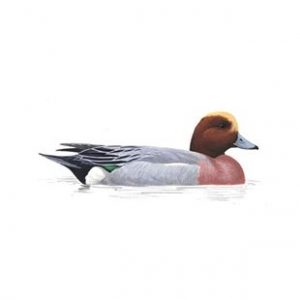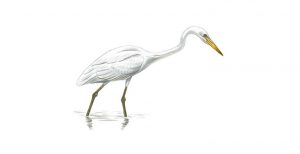The final two months of 2019 were dominated by prevailing westerly weather systems, resulting in a rather mild, wet period. This was particularly noticeable in December during which above average temperatures were recorded, along with fewer than normal frosts.
With most of the autumn migration concluded by mid-November, there was not much to get the birding fraternity excited about weather-wise, save for the odd strong depression. But we birders are a persistent bunch, ever optimistic that we’ll manage to ‘pull a rabbit out of a hat’ or rather connect with something out-of-the ordinary, even if the weather conditions are not that conducive.
Despite the mild temperatures, early winter wildfowl numbers were a little better than in 2018, albeit off an awfully low starting base. Following this autumn’s influx, Shoveler were present throughout the period with a peak of 20 on 29th November. Wigeon (illustrated above) put in a better showing, with three sightings of nine on 17th November, four on 24th November and a group of six on 28th December. An unexpected recorded sighting was of a female Mallard with eight tiny duckling on 29th November, very unseasonal and perhaps a sign of the milder conditions; sadly none of the young are believed to have survived. Great Crested Grebe numbers were consistent throughout with peaks of 16 in November and 17 in December, while there was a single report of a Little Grebe on 10th November. Few Snipe were reported, with the highest count submitted being six on 20th November.
The sighting highlight of the period was that of a Great White Egret (illustrated above). It appeared early afternoon on 16th November and was seen to roost with four Little Egrets in the willow islands later that day. During its four-day stay the egret was elusive, usually being seen in flight as it traversed the Pond between various favoured fishing spots. This is the fifth recording of Great White Egret at Fleet Pond. November seems to be a favoured month with two of the five records to date, the others coming from May, October and December. It was also notable for its length of stay as all previous records were of one-day wonders. As this species consolidates its foothold in the UK, (they are now breeding in at least six English counties, mainly in the southwest and East Anglia) further sightings at Fleet Pond should be expected.
Winter roosts included peaks of 350 Jackdaw on 16th November and 325 on 28th December; 210 Magpie on 28th December and 40 Redwing on 29th November. Further feeding flocks of Redwing included 50 near to Coldstream Marsh on 4th November.
Warbler sightings were restricted to a burst of song from a Cetti’s Warbler on Coldstream Marsh on 4th November and a late Chiffchaff on 9th November. Limited winter finch flocks were reported, with most identified as Goldfinch (illustrated below), including a flock of 150 on 2nd November. There were few reports of Siskin, with no counts exceeding ten thus far this winter, which perhaps reflects the milder weather.
As a new decade begins, it’s time to reflect on the hopes and dreams of the next decade. Certainly, the ecosystems at Fleet Pond will be under pressure from further close-by urban development, increased recreational visitors and climate change. Consequently, it is all the more important to advocate for the protection of this near ‘island’ of valuable biodiversity right on our doorstep.
How will the birds fair? Frankly I don’t know, but there will be winners and losers. Why not pick up your binoculars and start recording your bird sighting at the Pond? You can do this via Apps and sites such as BirdTrack, eBird or HOS’s GoingBirding. By recording your sightings in this way you will be providing valuable data to help us track the everchanging fortunes of our birds.
For the regulars, hang in there – not long now until spring migration in early March. Here’s to a decade of good birds and birding at Fleet Pond!
William Legge
Contributing observers: Evelyn Auld, David Buckler, John Clark and Graham Stephenson



